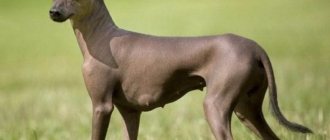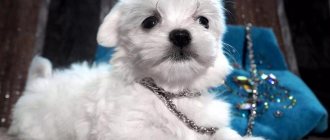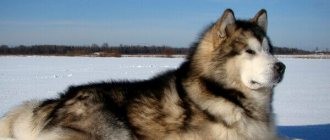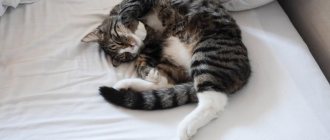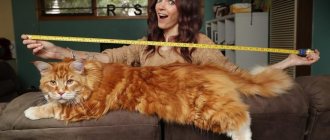Sphynx cats are unusual, graceful, intelligent animals. The article will tell you about the peculiarities of keeping Canadian and Don sphinxes, their character and behavior.
Having once met the Sphynx, many cat lovers decide to have a small representative of this hairless breed in their home. These cats are capable of charming with just one glance, and with their grace and alien appearance they can forever make a person fall in love with them.
Sphinxes are graceful, flexible animals
In order to avoid making a mistake when choosing a pet, it is necessary to take into account the differences in Sphynx breeds, as well as take into account the peculiarities of the maintenance and behavior of these cats.
Canadian and Don Sphynx: description of cat breeds, colors, photos
Sphynx cats have a flexible, muscular, round body and long, elastic legs. The tail of sphinxes is usually straight, but sometimes it is pressed tightly to the side in the form of a ring.
The Sphynx's tail can be pressed to its side
The head is rounded, slightly oblong, with prominent cheekbones, a straight nose and wide, large ears, rounded at the ends. The entire body of the sphinx is covered with thick, suede-like skin that forms folds.
IMPORTANT: The “folding” of sphinxes is an indicator of age. There are a lot of folds on the body of kittens, while the “oldies” have folds only in the area of the neck and abdomen.
Folds on the body of a “rubber” Sphynx kitten
A distinctive feature of Sphynxes is their dense, rounded belly, when you look at it you might think that the animal has recently eaten heavily.
Canadian and Don Sphynxes have many similarities, the most important of which is the almost complete absence of hair on the skin. Despite this, cats and Sphynx cats can come in a wide variety of colors. This is acceptable and must be noted in the animal’s pedigree.
Sphynxes can have different colors
Each color, shade, color of the skin of sphinxes corresponds to a specific letter of the Latin alphabet.
There are 7 solid colors:
- black ( n )
- blue( s )
- chocolate ( b )
- lilac ( s )
- red ( d )
- cream ( e )
- white ( w )
In addition to plain ones, sphinxes can have bi-color and intermediate colors. Sphynxes of bath, color-point, and Harlequin colors look unusual.
Red Sphynx kitten
IMPORTANT: Tortoiseshell coloring is the norm only for Sphynx cats. Sphynx cats of tortoiseshell color are a kind of natural error. The gene mutation that leads to the appearance of tortoiseshell seals deprives them of the ability to reproduce. Otherwise, these animals are no different from their own kind.
Don Sphynxes can be:
- naked - completely bald, there are a large number of folds on the body
- flock - the body is covered with barely visible hair, feels like a peach peel
- velor – hair on the body is noticeable, reaches 3 mm
- brush - a body under coarse fur, these sphinxes cannot take part in exhibitions
The Sphynx's skin may be covered with thick fur.
Main differences between breeds
| Characteristics | Canadian Sphynx | Don Sphynx |
| Body | Elegant, quite compact, with long limbs, folds on the skin, localized mainly in the armpits and in the neck area. The animal is very graceful. | Quite squat, but proportional, with well-developed legs, a wide chest, good muscles. |
| Head | Small, prominent, with a clearly visible transition from the forehead to the nose. | Wedge-shaped, with well-defined cheekbones, wide at the top and tapering downward. |
| Ears | Large, set quite low, widely spaced. | Large, long, straight, located high. |
| Eyes | Large, round, wide open. | Almond-shaped, set slightly at an angle, small in size. |
| Mustache | None. | They may be small, as if broken off, sometimes they resemble small bent antennas. |
| Hairline | Barely noticeable fluff. | Completely absent, some individuals have a little hair on the head, paws, and tail. |
| Teeth | Good teeth, but some individuals have a predisposition to teeth diseases. | Strong, white enamel. |
| Jumpability | Due to their body structure, they jump well and far and can move to a fairly high place. | Not very jumpy. |
| Character | Soft-spoken, friendly, can be a little reserved. | A curious and active animal with a strong psyche, contented and willful. |
| Genetic characteristics/hairlessness gene | Recessive. | Dominant. |
The difference between the Canadian Sphynx and the Don Sphynx
A non-professional is unlikely to immediately find the differences between the Don and Canadian Sphynx. And these differences are not so important for those who simply have a hairless cat as a pet. However, if it is planned to produce offspring from a kitten in the future, the breeder needs to know how the Sphynx breeds differ.
IMPORTANT: The main difference between Sphynxes is the hairlessness genes. All Canadians are carriers of the recessive gene, and the Don Sphynxes are carriers of the dominant gene. This means that there is always some hair on the body of the Canadian Sphynx, and the Don Sphynxes are often completely hairless.
Upon closer examination, you can notice other differences between the Don and Canadian Sphynx, which include:
- Head shape . Don Sphynxes have clearly defined cheekbones, a wedge-shaped skull, sloping in the forehead area. Canadians have a narrower skull
- Don Sphynxes have mustaches
- look , his eyes are always wide open. Don Sphynxes have more slanted eyes
- tail , with a tassel at the tip, while Don Sphynxes have a straight tail.
- The body of a representative of the Don breed is more muscular and strong than that of the Canadian Sphynx
Canadian Sphynxes are distinguished by their “open” gaze
IMPORTANT: In addition to external differences, the Don Sphynx differs from the Canadian Sphynx in its friendliness, sociability and more balanced behavior.
Origin story
First of all, the difference between these two breeds lies in their origin.
The birthplace of the Canadian sphinxes, as their name suggests, is Canada, or more precisely, the city of Ontario. It was in this second largest city in the country that the purposeful breeding of unusual hairless cats first began in the sixties of the last century.
It all started with a hairless kitten, born to an ordinary domestic cat, which, due to the lack of fur, was significantly different from its brothers and sisters. The amazing baby was named Prune. He turned out to be a carrier of the gene responsible for hairlessness.
But Prun was not destined to become the founder of a new unique breed of cats, since the breeders made one serious mistake. They crossed Prun exclusively with his sisters and nieces, and after several generations, the kittens, due to such close family ties, were born weak and often died a few days after birth.
Perhaps the world would never have known about the Canadian Sphynx if not for another hairless cat who was born in the American city of Wadena, and who was named Epidermis. American breeders turned out to be more cautious than Canadians, so they tried to find a cat to mate with Epidermis, with whom he would not be connected by blood ties.
Canadian Sphynx
There is a version that the Americans still managed to find distant descendants of Prun, who, together with Epidermis, were used for selection work to develop a new breed. This time, the breeders were lucky and were able to get several generations of completely healthy hairless kittens. The new breed was called the Canadian Sphynx, in honor of the first hairless cat born in Canada.
Don hairless cats are more than thirty years “younger” than their Canadian counterparts and appeared a thousand kilometers from America - in the Russian city of Rostov. Their story began with the bald cat Varvara, who was sheltered by a woman with a kind heart, Elena Kovaleva. Convinced that the pet’s hairlessness was due to some unknown disease, Elena even turned to veterinarians to cure her. But Varvara surprised her mistress by giving birth to babies as hairless as herself.
Russian breeders became interested in the unusual hairless kittens and wasted no time in starting selection work to breed them. The Russian sphinxes received their name in honor of the mighty deep river - the Don.
The difference between these two breeds is not only in their origin, but also in the fact that Canadian Hairless cats are today recognized by all international cat organizations, while the Don have received the status of only an experimental breed.
Don Sphynx
Hairless Sphynx cat: character
The unique character of the Sphynx, as well as their appearance, is the result of careful selection. These animals are not prone to displaying aggression or discontent. Kind, soft, sensitive, gentle, devoted Sphynxes are ideal pets.
They get along well with both older people and families with small children. A balanced character combined with a playful disposition helps these animals share the interests of each family member.
Sphynx cats get along well in families with small children.
IMPORTANT: Sphinxes are not vindictive, they quickly forget random insults, but they have a hard time experiencing loneliness.
Sphynxes love to interact with people and pets. They are not afraid of large dogs and lack the hunter's instinct, so a hairless cat's best friend can be a huge bulldog, a hamster or a parrot.
Sphynxes are playful and curious animals
Nicknames suitable for Sphynx cats
Even the Sphynx kittens look majestic and proud, their entire appearance reminiscent of Egyptian figurines. Calling the Sphynx a simple cat name, such as Timka or Fluff, doesn’t even occur to us.
In order not to invent anything new, you can simply look at the list of names of Egyptian gods. A name suitable for the little miracle will be found there quickly.
For example, a Sphynx cat can be named after one of the goddesses: Amaunet, Anuket, Isis, Seshat, Sioux . Suitable names for a sphinx boy are: Aker, Amat, Amset, Anhur, Geb, Mafdet, Onuris, Osiris, Hapi, Hesat, Khnum, Shai, Yah.
The names of ancient Egyptian gods suit the majestic sphinxes
Mating
Males of these breeds reach sexual maturity by the age of one year; in females, the first estrus usually occurs at the age of 6-8 months. There is no need to breed sphinxes during this period. It is recommended to carry out the first mating at the age of 1.5-2 years; by this age they can already produce full-fledged offspring.
Traditionally, the female is brought to visit the groom, whose owner prepares all the conditions for the “wedding.” The most favorable moment for this is 3-5 days of estrus. Cats should be comfortable and not be distracted by anything. For the bride, you need to prepare a place where she can hide if suddenly she actively does not like the proposed groom.
Before mating, both animals must be examined by a veterinarian and their claws trimmed. A course of anthelmintic drugs must be administered within 2-3 weeks. It is strictly not recommended to bathe a cat before mating. The cat must feel the specific smell emitted by the animal during the period when the hormonal background is most consistent with procreation.
Canadian Sphynx
Hairless cat - Canadian Sphynx: care
The main feature of keeping sphinxes is the need for regular bathing . Bath procedures are carried out at least twice a month.
Adult cats are bathed in a bathtub, kittens - in a basin or sink. Soapy bathing water should not be cool - sphinxes need warmth.
Adult Sphynx cats are bathed in a bathtub
Using a soft washcloth, carefully remove dirt from the body, face, tail and paws, paying special attention to the folds, then rinse the animal in clean water.
IMPORTANT: Due to the fact that hairless cats constantly sweat, they themselves and the objects they touch with their sweaty bodies acquire a brownish tint after drying.
If the sphinx is not against bath procedures and enjoys playing in the water, you can offer him children's rubber toys. If the animal is frightened and is trying with all its might to avoid the upcoming procedure, you should talk to it in a gentle, calm voice.
Sphynx cats love to play while bathing.
At the same time, you should not make sudden movements or raise your tone. After bathing, the cat is “blotted” with a dry, warm cotton towel. In addition to bathing, hairless cats need to be dried daily with soft wipes.
Sphynx cats need regular manicures , as brown sweat mixed with dirt quickly covers the top and gets stuck inside the overgrown claws.
TIP: Hold your cat firmly and apply gentle pressure to the pad of the paw to expose the overgrown claws. Using gentle movements, cut off the overgrown part. To avoid cutting off excess, you should not cut close to the base.
The ears of sphinxes, as well as their claws, suffer from a large accumulation of fat and dirt in them. You can clean your cat's ears using cotton swabs or turundas moistened with warm water. Contaminants are removed only from visible parts of the ear, avoiding contact with the ear canal.
Sphynx ears need to be cleaned regularly
Content Features
- Sphynxes are thermophilic , so they need to be kept in a warm room. Outdoor living is prohibited.
- Due to increased heat transfer, the Don Sphynx consumes a little more food than other cats.
- In front of the eyes, due to the lack of eyelashes, mucus may accumulate in the conjunctival sacs, which must be removed with a clean cloth or cotton wool.
- Bathing can be replaced by rubbing.
- When kept with other animals and children, the cat does not have conflicts.
- Males rarely “ mark their territory ,” and female cats go into heat relatively rarely.
- There is no characteristic cat smell, no fur remains on things.
- People who are allergic to cat fur are less likely to have allergic reactions to the presence of Don Sphynx cats .
- Kittens quickly and quite easily learn to go to the toilet.
- Most sphinxes get used to a single owner and remain devoted to him.
- Cats are affectionate and touchy (but not vindictive), which will require a lot of attention from the breeder.
What to feed a Sphynx cat?
Sphinxes are real gluttons. They love to eat and gobble up even the simplest food with appetite, be it porridge or soup. However, it is too early to rejoice. Due to its accelerated metabolism and sensitive digestive system, the Sphynx requires a varied, balanced diet.
Sphynx cats are happy to try new dishes
Twice a week you should offer your animal canned meat. The Sphinx's menu must include raw fish, meat, boiled liver, dairy products and dry food. Fresh drinking water should always be freely available.
IMPORTANT: Overheated or supercooled food is unacceptable. Sphynxes are allowed to be fed food at room temperature.
Diseases of Sphynx cats
The most vulnerable place of every hairless cat is its skin. Due to excessive secretion of sebum and untimely removal of it, acne .
To get rid of purulent lesions on the skin of an animal, you need to contact a veterinarian, who, after assessing the situation, will prescribe treatment.
Sphynx acne
IMPORTANT: A Sphynx will have healthy skin if its owners pay enough attention to the pet’s hygiene. By bathing your animal 1 – 2 times a week, you can prevent the appearance of acne and pustules.
In addition to skin rashes, Sphynx cats often suffer from a number of other congenital and acquired diseases, including:
- Microphthalmos is a reduction in the eyes of a kitten that occurs as a result of infections suffered by the pregnant mother. The progression of the disease often ends with a tumor. Surgery will help correct the situation
- Curvature of the spine - the disease develops in the caudal part of the spine and is accompanied by dwarfism and pathologies of the bone and digestive systems. Occurs as a result of inbreeding or is inherited
- A shortened jaw is a congenital defect. It may be mild and not affect the general condition of the animal in any way, however, such sphinxes must be sterilized, since they cannot take part in breeding
- Vasculitis is inflammation of blood vessels, which appears on the skin as red and blue dots and spots of different sizes. The disease can either disappear on its own without a trace or be complicated by inflammation. The causes of vasculitis are: internal diseases, stress, reaction to drug treatment
- Entropion is a congenital pathology in which the edges of the eyelids are unnaturally turned inward. The situation is fraught with the development of chronic conjunctivitis in the sphinx. The problem can be solved through surgery
- “Falling asleep” kittens is the appearance of non-viable offspring as a result of crossing two “rubber” sphinxes. Kittens are born very weak, their skin has a bluish tint, and vital organs may be missing or not functioning. There is nothing we can do to help these animals.
Sphinx's eyelids turn upside down
Petersburg (Peterbald) Sphynx
This breed belongs to the hairless Russian domestic cats. Sphynxes of the Peterbald breed look quite elegant, these cats are graceful and slender, have a very characteristic head shape: narrow and long, with a straight distinct profile, large and almond-shaped eyes, the ears of this breed are set apart. The best representatives of this breed look like oriental hairless cats . Petersburg (Peterbald) Sphynxes have a wonderful character, they are curious, friendly, very active and intelligent. Sphinxes love absolutely all family members and require communication from them; These cats are not independent cats. Peterbalds get along well with other cat breeds and with other pets, and are also good with children. Sphynxes of this breed are not vindictive; all these qualities make St. Petersburg (Peterbald) excellent companions.
The St. Petersburg breed (Peterbald) was acquired in 1994 in Russia, the city of St. Petersburg, as a result of an experimental mating of the World Champion, the oriental cat Radma von Jaegerhoff, with the Don Sphynx Afinogen Myth. This breed of cat was bred by well-known felinologists in Russia O. S. Mironova with the participation of Tatyana Komarova. As a result, four Petersburg Sphynx (Peterbald) kittens were obtained from the first two litters: Nezhenka from Murino, Nocturne from Murino, Mandarin from Murino and Muscat from Murino. These kittens are the first founders of the Peterbald Sphynx breed.
In 1996, the St. Petersburg Sphynx breed was recognized by the SFF-Felinological Breeding Federation, and then a standard for this breed was adopted with the assignment of PBD - an abbreviation. In 1997, this cat breed was recognized by TICA - The International Cat Association and assigned this cat breed PD - an abbreviation, and in 2003, this cat breed was recognized in the WCF - World Cat Federation with PBD - an abbreviation. Other possible abbreviations and designations for this cat breed are PSX, PD, PTB and PBD. Nowadays, this breed of cats is developing in the direction of the Siamese and extreme oriental type: a long muzzle, large and almond-shaped eyes, ears, in this breed, set apart, flat cheekbones and a graceful, elegant body on high paws. That is why all existing standards of this breed allow St. Petersburg (Peterbols) mating with Siamese and Orientals , as well as semi-long-haired variations (Javanese and Balinese) .
The Petersburg breed (Peterbol) was taken by introducing the dominant hairless gene Hrbd into the population of Siamese-Oriental cats, borrowed from the Don Sphynxes.
Hairless cats have skin that behaves like human skin: in the summer it tans under the sun's rays and sweats when it is very hot. rubber sphinxes, it is very sensitive to radiation and often dries out, it is also susceptible to mechanical damage and needs special protection (lubricating with baby oil can help). In places of contact, the skin acquires strong pigmentation, and if there is insufficient sunlight, the skin loses pigment (in winter, the sun tan disappears), and remains only in moles and migrating “winter spots.” During lactation and pregnancy, pigmentation increases.
In the absence of fur, the color appears like a tattoo directly on the cat's skin. However, the skin pigment only provides a “shadow of the color”, which makes it difficult to distinguish between clear color variations of lightened and main colors. For example, the reddish brindle color of a cat will look, on a fully undressed adult cat, the same as a cream, spotted color, that is, it will visually look uniformly pink.
Only a breeder can determine the genetic color of a young kitten in its first years of life, while it still retains its baby fur. Animals of colorpoint colors sometimes have blue eyes. And in an adult individual it shows that it belongs to animals of acromelanic color. Examination at exhibitions is carried out without taking into account the types of patterns, and only at the base they are separated by agouti or non-agouti coloring.
Sphynx kittens open their eyes very early, this directly affects the degree of hairlessness in the kitten. If brush and velor kittens' eyes begin to open from the third to the fifth day of their life, then naked-born kittens are immediately born with their eyes open. And in other representatives of cat breeds, early opening of the eyes leads to blindness and drying out of the eyeball, but in sphinxes the eyes are already normally fully developed at birth, they can blink and squint, and the lacrimal glands well moisturize the mucous membranes. As a result of the same factor, in older Sphynx cats , increased lacrimation occurs, this is especially noticeable during the feeding : not many (especially naked “rubber”) cats cry, one might say crocodile tears, at the moment when they eat.
What is the distinctive feature of the Sphinx ? This is the so-called secretion of skin lubricant (a reddish-brown, waxy sticky substance) and it accumulates around the ears and claws (which sometimes causes panic among inexperienced veterinarians). However, this is a way of additionally protecting the body from the influences of the external environment. And if a Sphynx cat (light color) looks a little grimy, there is no need to subject its skin to thorough and frequent water treatments with special shampoos, but it is recommended to wipe its body with a soft cloth soaked in special oil intended for children. But an adult cat that has retained hair in places will not have such excessive skin discharge, and the cat’s owner can limit himself to only periodic cleaning of the ears.
The hairlessness gene affects both the structure of the coat and the whiskers (cat's whiskers): in heterozygous cats, this gene is preserved and sufficiently developed from birth (this often helps to determine the carrier of the hairless genes in the first moments of life). The whiskers in homozygous cats may be greatly shortened and thinned, or absent altogether.
Clothing for Sphynx cats
Gentle, trembling sphinxes with their entire appearance make it clear that they love warmth very much. If a hairless cat lives in a warm apartment and does not walk outside, he will not need special clothing.
It is enough to simply arrange a bed for the animal near the battery so that it can spend time with maximum comfort.
IMPORTANT: If the bald Sphynx is taken for a walk outside or on the balcony, you should take care to protect the pet’s delicate body from the winter cold and scorching summer heat.
A winter costume for a sphinx must be windproof and must cover the chest, back and stomach. Having exposed her delicate bald body in the cold, the sphinx can become hypothermic and get sick.
In summer, the Sphynx will need airy, lightweight clothing that will protect the animal from sunburn and heatstroke. You can make clothes for the sphinx yourself or buy them in a specialized store.
Clothes for the sphinx
Where is the best place to buy a Sphynx kitten?
Those who decide to get a Sphynx should definitely contact professional breeders. By purchasing a kitten at a club or at an exhibition, you can avoid problems with the health of the animal and receive guaranteed lifelong information support and support from experts in the breed.
Club Sphynx
If you still doubt whether you should have a Sphynx at home, answer yourself one question: “Do you want to get a reliable, faithful friend who does not remember insults, will be devoted to you, and will never turn away?” If the answer is yes, feel free to cast aside all doubts and take a step towards a small bald miracle.
Character traits
Sphinxes, living in the vastness of Russia, are reminiscent of playful children in their disposition. These are perky creatures who are never characterized by aggression. They love human company very much. Sometimes this takes the form of obsession. Then the pebble appears everywhere your foot steps. He starts his song, rubbing himself against your hands or face.
The pronounced curiosity and desire to always be at the epicenter of events are striking. They treat strangers with interest, but do not always allow them to approach them once they reach puberty. They are sensitive with their family members and subtly sense people’s moods.
Their Canadian counterparts behave differently:
- choose their only owner;
- feel equal to a person, not allowing themselves to beg for food;
- sometimes show impulsiveness;
- a little secretive, “on their own”;
- restrained in their actions;
- Only a select few allow themselves to be caressed.
At the same time, they are all very peaceful. They are endlessly devoted to those who care about them.
